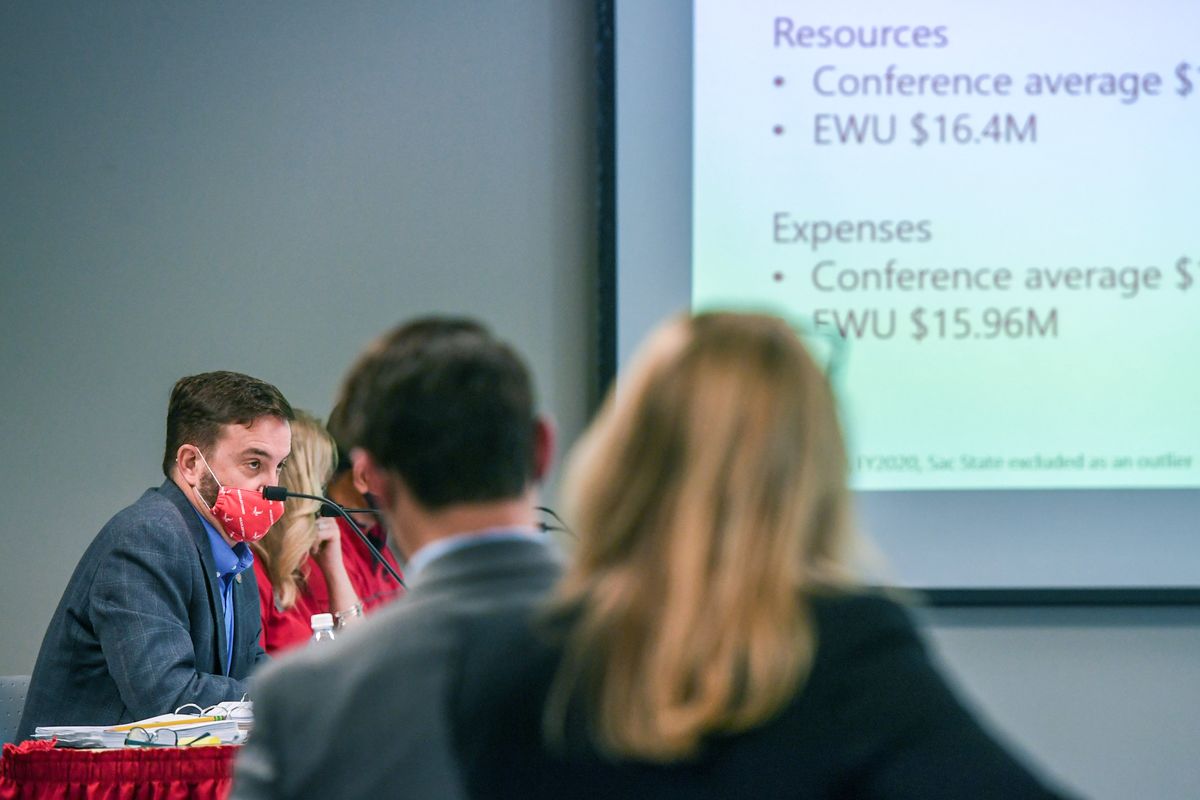Faced with equity concerns, EWU athletics aims to focus on ‘revenue problem,’ not spending

CHENEY – Faced with equity concerns, Eastern Washington University has a new plan to offset its athletics budget shortfall that doubles down on methods to increase revenue, rather than substantial budget reductions.
Four months ago, it looked as if Eastern Washington University would pull back on funding support for some sports programs to help fix the financial problems plaguing the university’s athletics department, which is running on upward of a $2.8 million shortfall this year.
President David May said Thursday the concept has been scrapped partly due to the university’s responsibilities related to federal Title IX regulations, which require that men and women are provided equitable opportunities to participate in sports.
“It would be difficult to tier the less revenue-generating sports without making our participation-opportunity situation worse,” he said. “And so, we’d end up reducing support for sports which are actually more revenue generating, which then we’re sort of just chasing our tail in terms of a budget perspective.”
Instead, in the name of fostering an athletics program that’s sustainable, equitable and competitive, May and the university administration have recommended raising more money instead of cutting what’s there.
“I think the takeaway … for me, and what I would like to suggest to you all, is that Eastern Washington University doesn’t have a spending problem,” May said to the board. “We have a resource problem, which really means we have a revenue problem. How we generate revenue for the program is the crucial question moving forward.”
In June, trustees voted in support of May’s recommendation to keep EWU athletics competing in the NCAA Division I Big Sky Conference.
The measure was among the options outlined to university officials by The PICTOR Group, a consulting firm hired to evaluate ways to create a more sustainable budget for an athletics department that has racked up a multimillion-dollar deficit since 2014.
Since this summer, the future of the athletics department has been evaluated by a team that includes May, Athletics Director Lynn Hickey, Vice President Barb Richey, Vice President Mary Voves and Mark Baldwin, special assistant to the president.
May said the group benchmarked EWU’s athletics spending and revenue against that of other Big Sky Conference programs. Data from Thursday’s presentation showed EWU’s $15.96 million in athletics expenses in the previous fiscal year was below the Big Sky Conference average of $17.96 million.
Income levels were also lower, with EWU clocking in at $16.4 million versus an $18.06 million conference average.
“The direction from the Board of Trustees was to build and maintain a Division I Big Sky (Conference) athletics program,” May said. “I don’t believe that we can reduce budgets further and still maintain the capacity to meet the request from the board.”
May said he believes the university can do a much better job with netting private donations to the level of EWU’s Big Sky peers. With revenues including ticket sales, donations, student fees and sponsorships, Big Sky schools averaged $10.72 million.
By comparison, EWU accrued only $7.14 million.
Levels of institutional support, which fall under the category of revenues, to EWU in the previous fiscal year – $9.26 million – were roughly on par with the Big Sky average, $8.58 million.
“It seems to me that operations are an expense item that really is a responsibility of the state rather than private donors,” said Trustee James Murphy, adding that he would rather see donations go toward “student success,” such as through scholarships.
To this end, the president is calling for the university to plan accordingly to ensure stable staffing dedicated to fundraising efforts. Like other business sectors across the country, staffing for EWU has been a problem in recent months, May said.
“We don’t overspend. Our coaches are very frugal and we’re very efficient. Now, can we always improve on that? Sure,” Hickey said, “but we’ve got to do a better job of finding revenue sources and fundraising. … Right now, we don’t have the staff in place to double or triple our fundraising.”
Speaking on The PICTOR Group recommendation of tiered sports budgets, Hickey said “that’s kind of already going on.”
Even so, Hickey said coaches and the athletics staff will have to improve on efforts to recruit regionally, rather than nationally or internationally, to better manage costs.
“I think what will be more formalized as we really work on the Title IX plan on the roster management piece in really looking at asking some sports to reduce the number of total students they have participating and asking other sports to increase it,” she said, referring to walk-ons, not scholarship athletes.
May said the athletics review remains ongoing, as the team is working to develop a three-year plan as well as a five-year plan.
With the budget largely set for the 2021-22 fiscal year, which runs through June, May said the next step is to address an operational revenue gap in the athletics department.
The department could need anywhere from $2.8 million to $3.4 million to fill the shortfall, which exists, May said, after revenues suffered last year from the COVID-19 pandemic.
May said the administration will look to fill the gap through a number of options across the rest of the fiscal year, such as using unallocated institutional financial aid, and using any increased donor support and/or expense management practices by athletics staff to actively limit spending.
“I do not intend to create an athletics program that is platinum-level, diamond-encrusted. First of all, that’s not who Eastern is and that’s not what you asked me to do,” May said. “I want to create an athletics program that is sustainable, equitable and competitive, so we’re going to have a nice gold-plated plan.”